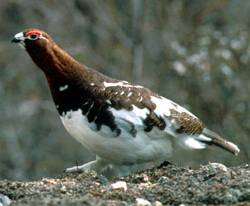Willow Grouse
|
|
| Willow Grouse | ||||||||||||||
|---|---|---|---|---|---|---|---|---|---|---|---|---|---|---|
 | ||||||||||||||
| Scientific classification | ||||||||||||||
| ||||||||||||||
| Binomial name | ||||||||||||||
| Lagopus lagopus (Linnaeus, 1758) |
The Willow Grouse (Lagopus lagopus) is a medium-sized bird in the grouse family. It is a sedentary species, breeding across northern Eurasia in birch and other forests and tundra.
It also occurs in Alaska, and northern Canada, where it is called the Willow Ptarmigan. It is also the state bird for Alaska.
The spring male is brown above with a reddish neck and white wings and underparts. The female is similar, but lacks the brown. In winter, both sexes become completely white. They can be distinguished from the winter Ptarmigan by habitat, larger size, thicker bill, and lack of black between the eye and bill in the winter male.
The distinctive British form, the Red Grouse (Lagopus lagopus scoticus) has sometimes been considered a separate species. It is a moorland bird, and is basically reddish brown in all plumages, never going white.
The male's song is a loud "go-back go-back".
These are hardy vegetarian birds, but insects are also taken by the developing young. The female takes all responsibility for nesting and caring for the chicks, as is typical with gamebirds.
Lagopus in the scientific name refers to the feathered legs.
Willow_grouse_standing.jpg
de:Moorschneehuhn ja:カラフトライチョウ lt:Žvyrė nl:Moerassneeuwhoen pl:Pardwa ru:Белая куропатка fi:Riekko zh:柳雷鸟
